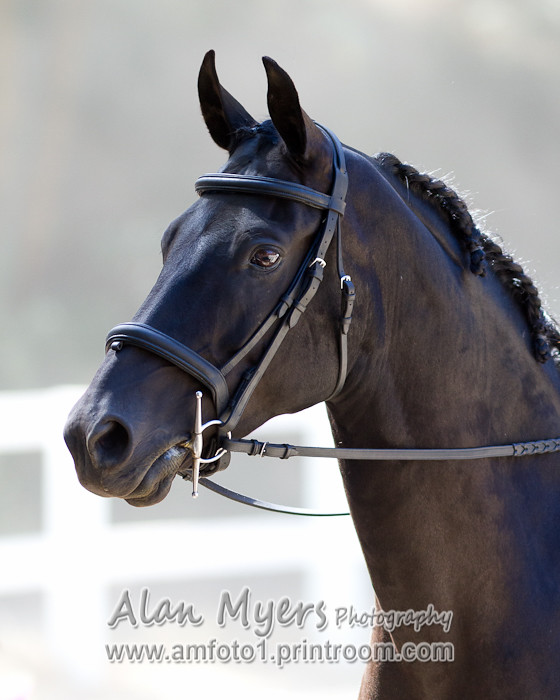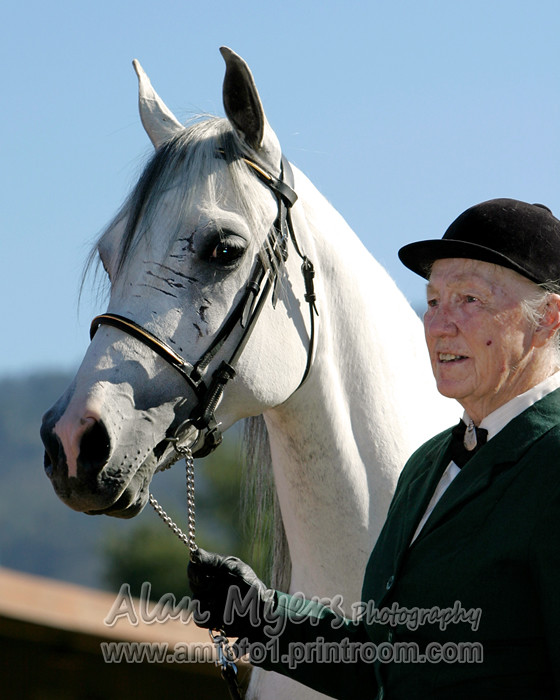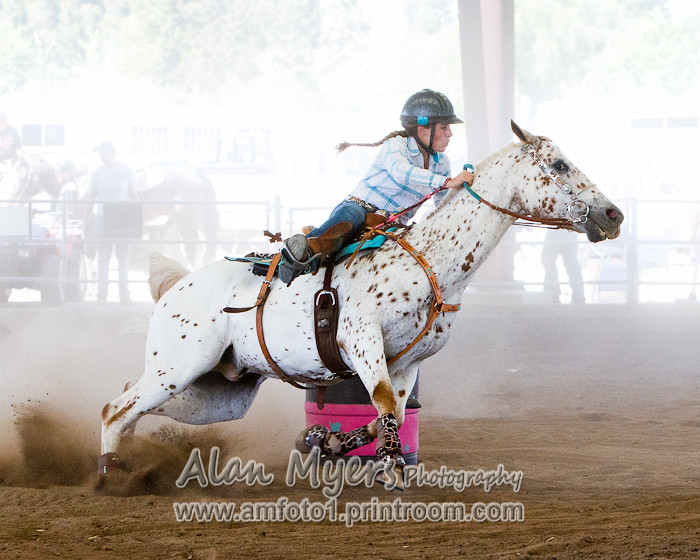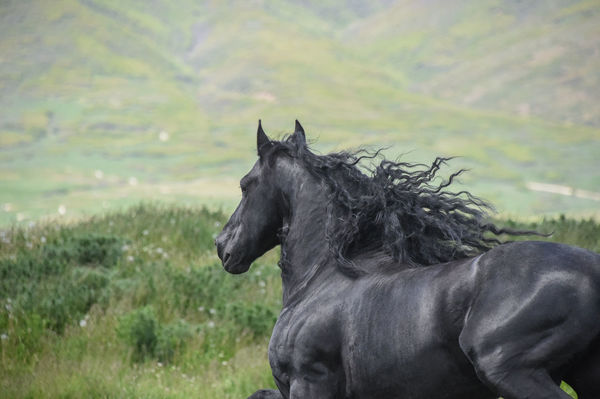Photographing black animals
Mar 1, 2018 10:20:15 #
it s like taking pictures of crows , they never look great .snow white birds are similar .not too many black horses out there .
Mar 1, 2018 10:28:57 #
Mar 1, 2018 10:39:00 #
billnikon
Loc: Pennsylvania/Ohio/Florida/Maui/Oregon/Vermont
Kathy d wrote:
I do a lot of horse photography and have great difficulty photographing Black Horses. I do not seem to be able to pick up the detail.
Any suggestions?
Any suggestions?
When most camera meters black, they want to open up, decrease exposure, you loose detail. The opposite happens with snow, the camera wants to stop down. SO, you must use exposure compensation to adjust. So, when your camera opens up for the black horse, you must go a -1 to -2.5 in exposure compensation when in Aperture or Shutter priority, or Program. OR, you can shoot in manual and adjust exposure until you get what you like in detail.
Mar 1, 2018 10:39:19 #
You’ve already received great advice on exposure compensation. Time of day is also very important. I do a lot of photography for a local wildlife preserve. I’ve found I need that low morning or evening side lighting to really get the best detail for dark coated animals.
Mar 1, 2018 10:56:09 #
GLKTN
Loc: TN
If possible, shoot first picture with gray card in front of horse. Simple click in PS/LR to get correct color.
Mar 1, 2018 11:28:45 #
amfoto1
Loc: San Jose, Calif. USA
Photographing unusually dark or unusually light colored subjects is difficult because your camera's metering system is being "fooled". It's always looking for "18% gray", so when something is darker than that, it will tend to want to over-expose (something lighter than "average gray" it will want to under-expose).
If using any of the auto exposure modes, you need to override the camera's tendencies with Exposure Compensation... using some minus E.C. with black, or some plus E.C with white subjects. If shooting manual exposure (NOT manual with Auto ISO, which is another auto exposure mode), you need to make similar compensation.
I agree with the suggestion to shoot RAW... that will give you more latitude to adjust image brightness later in post-processing (which is best done on a calibrated computer monitor... most are overly bright when not calibrated, causing you to make your images too dark).
Also try to make the photo in shaded or overcast lighting, rather than bright, full sun.
Very few "black" critters are actually black. With black, some sort of reflector or fill flash can help open up shadows and find detail, too. In this case, the horse was standing near a white building and the arena sand tends to be high reflective...

Spot metering is not necessarily a good thing. If you do that, you will need to more precisely control Exposure Compensation (or manual exposure override). In fact, a wider metering method usually is more forgiving, when the tonalities throughout the scene average out to around 18% gray.... Both the images below were metered more broadly and actually shot with some + E.C. dialed in (tho a little less with the black horse than with the white).


Both the above venues I know very well from having shot there many times over the years.... so I know what works and what doesn't.
I also carry a separate, incident meter and use it in some of the trickier lighting situations. This type of meter measures the light falling onto a subject, rather than what's being reflected off of it. For that reason, incident meters aren't "fooled" by different subject tonalities. (It also serves as a flash meter, when needed.)
When out in full sun, that's often the trickiest of all. If possible, use some fill flash (most horses ignore it)...


Of course, flash isn't always possible, practical or even allowed. In those cases all you can do is keep shooting, then make adjustments later in post-processing. That's much more easily done if you shoot RAW files instead of JPEGs. But you need to have an image editing software and calibrated computer monitor to work with....

If using any of the auto exposure modes, you need to override the camera's tendencies with Exposure Compensation... using some minus E.C. with black, or some plus E.C with white subjects. If shooting manual exposure (NOT manual with Auto ISO, which is another auto exposure mode), you need to make similar compensation.
I agree with the suggestion to shoot RAW... that will give you more latitude to adjust image brightness later in post-processing (which is best done on a calibrated computer monitor... most are overly bright when not calibrated, causing you to make your images too dark).
Also try to make the photo in shaded or overcast lighting, rather than bright, full sun.
Very few "black" critters are actually black. With black, some sort of reflector or fill flash can help open up shadows and find detail, too. In this case, the horse was standing near a white building and the arena sand tends to be high reflective...

Spot metering is not necessarily a good thing. If you do that, you will need to more precisely control Exposure Compensation (or manual exposure override). In fact, a wider metering method usually is more forgiving, when the tonalities throughout the scene average out to around 18% gray.... Both the images below were metered more broadly and actually shot with some + E.C. dialed in (tho a little less with the black horse than with the white).


Both the above venues I know very well from having shot there many times over the years.... so I know what works and what doesn't.
I also carry a separate, incident meter and use it in some of the trickier lighting situations. This type of meter measures the light falling onto a subject, rather than what's being reflected off of it. For that reason, incident meters aren't "fooled" by different subject tonalities. (It also serves as a flash meter, when needed.)
When out in full sun, that's often the trickiest of all. If possible, use some fill flash (most horses ignore it)...


Of course, flash isn't always possible, practical or even allowed. In those cases all you can do is keep shooting, then make adjustments later in post-processing. That's much more easily done if you shoot RAW files instead of JPEGs. But you need to have an image editing software and calibrated computer monitor to work with....

Mar 1, 2018 11:37:48 #
Picture Taker
Loc: Michigan Thumb
It's the reverse of photographing in the snow you have to compensate the other way. It is posable to spot meter and get it.
Mar 1, 2018 11:38:53 #
Rick from NY wrote:
Uh - that is actually backwards. If you shoot white snow, you open up the exposure (overexpose the meter reading) and if you shoot black object, you stop down the exposure (underexpose.)
It sounds counter intuitive, but the meter will try to make white snow gray which means you need to OVER expose to get it back to white. Conversely, if you are shooting a black subject, the meter will try to make it gray by lightening the scene. You need to UNDER expose to get it back to black.
It sounds counter intuitive, but the meter will try to make white snow gray which means you need to OVER expose to get it back to white. Conversely, if you are shooting a black subject, the meter will try to make it gray by lightening the scene. You need to UNDER expose to get it back to black.
When you are right, you are right. My mistake here. Fought for years to get that ingrained, and still got it wrong.
My phrase to get it right....
If light or bright scene
Open up two stops
If dark or black scene
Close down two stops.
I did not utter my phrase when I answered this.
Sorry
Mar 1, 2018 13:05:22 #
I use a Nikon D4s camera with a 28-300 lens. I was returning from photographing a three day event in Colorado and had my camera set to auto iso for the evening performances in a dark arena. Donate and Jim Hicks graciously allowed me to photograph their Friesen stallions on the way home. It was the middle of a bright, sunny day when I took these photos. For what it is worth to this discussion, two of these photos were shot at ISO 20,000 and one of the photos was shot at ISO 11,400. Shutter speed on all three was 1/5000. The ISO settings were a complete accident that day, but I am not unhappy with the results.



Mar 1, 2018 14:06:24 #
Kathy - A good way to practice this is to photograph black birds (vultures, crows, ravens, blackbirds) and white birds (seagulls, egrets, ibises). Check your settings after each shot, and adjust by adding or subtracting light. This is how I taught myself to transition quickly between black and white subjects. Birds are easy to find; they are everywhere! The seashore is a particularly good place because you may have gulls (light) and pelicans (dark) side by side. I walked to the riverfront every day at lunch time, and there were many subjects to choose from. Dogs would be another good practice subject.
Mar 1, 2018 16:57:25 #
Kathy d wrote:
I do a lot of horse photography and have great difficulty photographing Black Horses. I do not seem to be able to pick up the detail.
Any suggestions?
Any suggestions?
To get detail in black objects requires two things: proper exposure and proper LIGHTING.
Proper exposure is obtained by reading a gray card in the same light as the horse, setting manual exposure, and using that.
Proper lighting requires modification of the light source(s)! By modification, I mean DIFFUSION. The only way to get detail in black objects is to wrap light around them so you have some specular highlights. In the case of hair, fur, or fabrics, a large, broad light source or a large diffusion panel, or just a cloudy day outside, will work great. Obviously, for a horse, the light source must be HUGE, relative to the size of the horse, so cloudy conditions are my favorite solution.
You can photograph a black cat in a coal bin and get detail in fur, coal, and surrounding dark areas, so long as you wrap the whole scene in light. This forms small, mirror-like (specular) reflections of the light source that define the shapes. So get the *horse* outside on a cloudy day, and — very important — do a custom white balance and manual exposure in reference to an incident domed meter or a gray card or One Shot Digital Calibration Target, and enjoy the results!
Exposing in raw mode and post-processing in Adobe Camera Raw (Lightroom and/or Photoshop) will allow you to manipulate the tones to your satisfaction.
Mar 1, 2018 17:03:26 #
Rick from NY
Loc: Sarasota FL
Mary White wrote:
Kathy - A good way to practice this is to photogra... (show quote)
Back before digital made it so easy to shoot "tests" and get instant gratification, I always recommended to friends/acquaintances who were getting grey snow and grey black labs to buy a couple of inexpensive teddy bears, one black and one white, and practice. Typically, you would put a card in front of each bear saying +1, +2 or -1 and -2 and then get prints made. (EDIT - I actually suggested that the shots be taken with slide film so that you can view them on a light table since some printing places did not accurately get the exposure nailed in the prints. Back in the day, if one did tests, chromes were the preferred way to view them)
then you can see what the best +/- setting was and use that as reference points. Digital made the wait shorter, but the basic test set up can still be valid today. Of course the trick is to get in close to the bears so each fills the frame so the meter is not influenced by surrounding area.
Couple of other points to make. The other advantage of using the teddy bears is that if you buy ones that have "fur" you can also learn how to tweak shooting black and white and still maintain details in the fur. If you open up 2 stops shooting snow, the snow WILL be white, but perhaps too white without any detail. Same thing with the black lab. I want the dog black, but not a black blob.
There is no one exposure for every setting and no substitute for practicing so you get to know your meter. Which of course brings in another point. The exposure one likes on a D800 may differ greatly from the exposure setting on a D750. In fact, you can actually have 2 different preferred settings for 2 identical bodies. I shot with a pair of D3S's for years and one of them was permanently set at - 1/2 stop exposure comp because it always overexposed by 1/2 stop. Know your gear.
Mar 1, 2018 17:12:57 #
TheDman
Loc: USA
Kathy d wrote:
I do a lot of horse photography and have great difficulty photographing Black Horses. I do not seem to be able to pick up the detail.
Any suggestions?
Any suggestions?
Make your background work for you. Try to shoot into an open barn or something that is dark. If your background is about as dark as the animal, you won't have exposure problems.
Here's an example; not a black horse, but you get the idea.

Mar 1, 2018 17:57:26 #
Rick from NY wrote:
Uh - that is actually backwards. If you shoot white snow, you open up the exposure (overexpose the meter reading) and if you shoot black object, you stop down the exposure (underexpose.)
It sounds counter intuitive, but the meter will try to make white snow gray which means you need to OVER expose to get it back to white. Conversely, if you are shooting a black subject, the meter will try to make it gray by lightening the scene. You need to UNDER expose to get it back to black.
It sounds counter intuitive, but the meter will try to make white snow gray which means you need to OVER expose to get it back to white. Conversely, if you are shooting a black subject, the meter will try to make it gray by lightening the scene. You need to UNDER expose to get it back to black.
The OP said he couldn't get detail, which means he is underexposing. Better to meter an 18% card, shoot RAW, and recover shadow detail.
Mar 1, 2018 18:25:18 #
It's much easier to get detail in the black horse if you have the sun/artificial lighting on the camera side of the horse. (Is that too remedial, or am I wrong? :-)) It's true of most anything, I think.
If you want to reply, then register here. Registration is free and your account is created instantly, so you can post right away.





